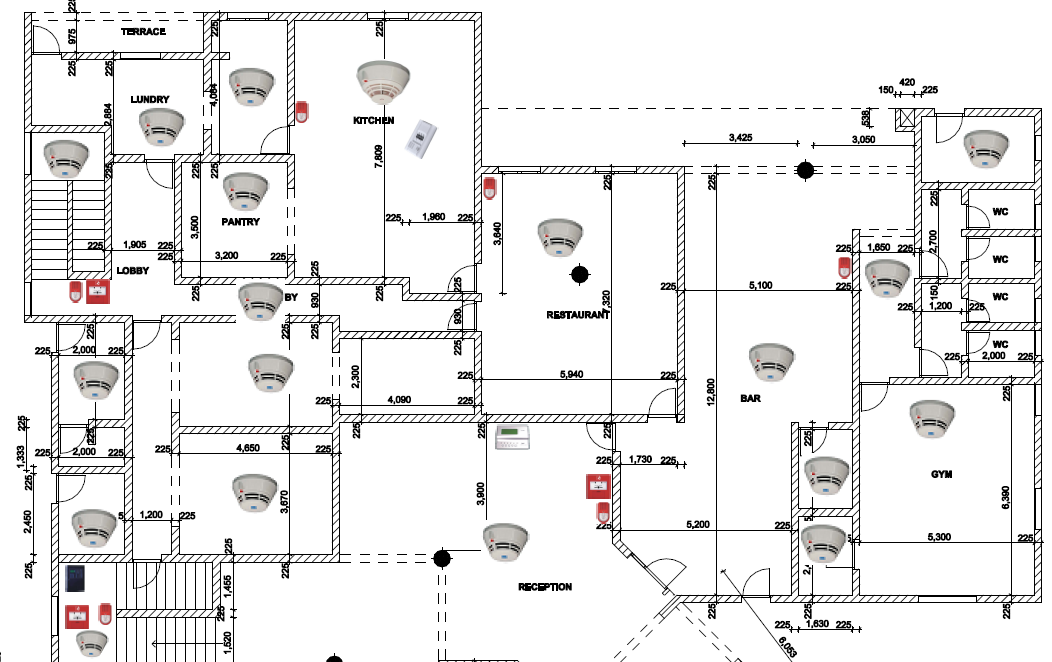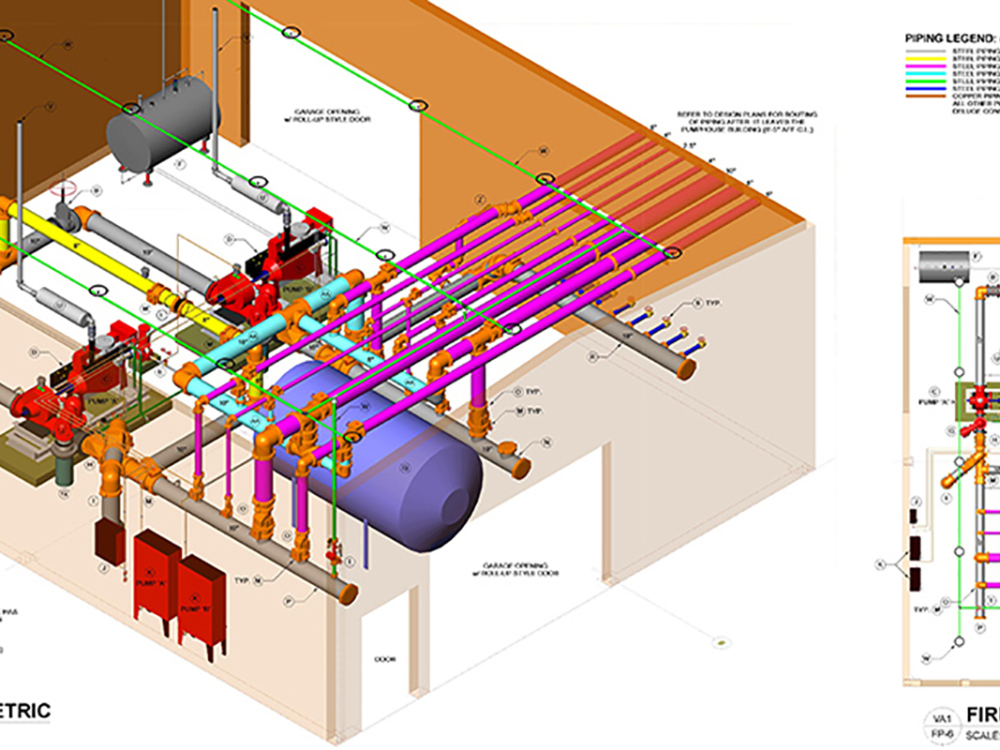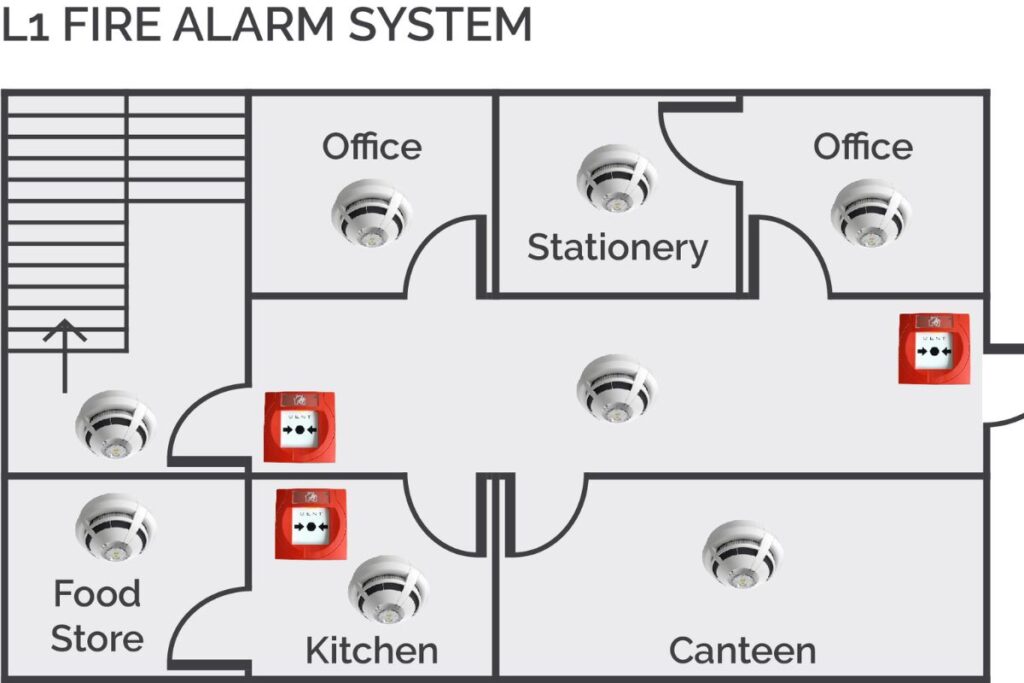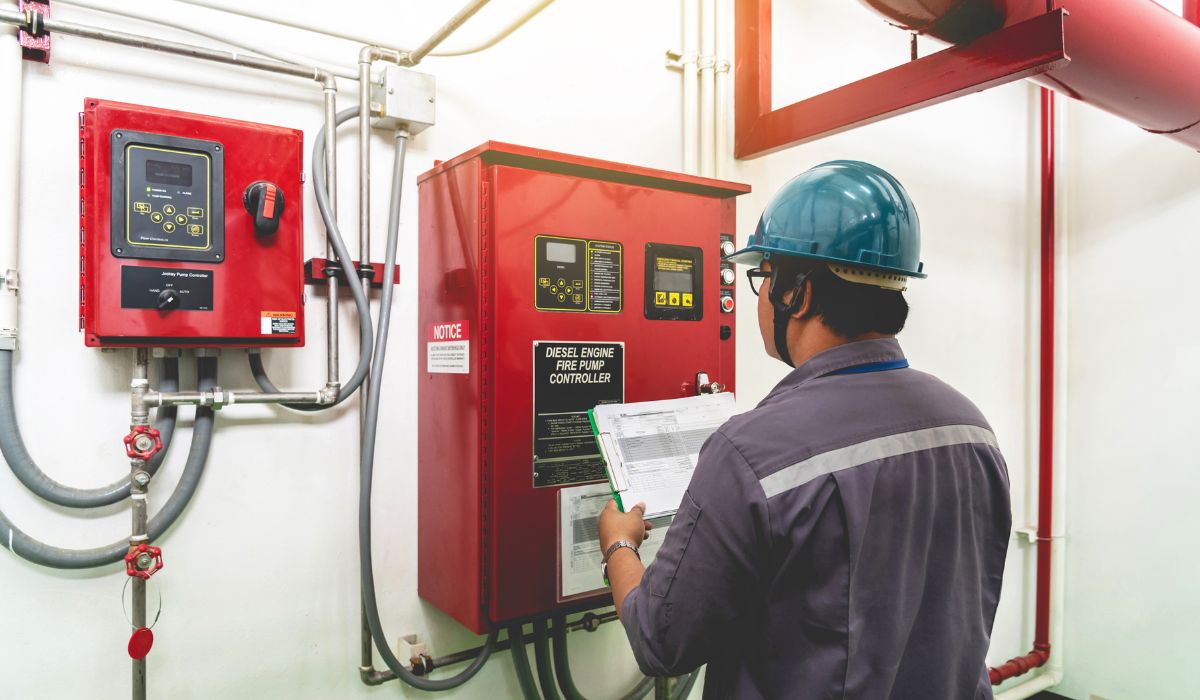Fire protection system design involves creating strategies and solutions to prevent, control, and mitigate fire-related risks. It ensures safety and compliance with regulations.
Effective fire protection system design is crucial for safeguarding lives and property. The process includes assessing risks, selecting appropriate fire suppression methods, and integrating detection systems. Designers must consider various factors such as building layout, occupancy, and materials used. They aim to create a comprehensive plan that addresses potential fire hazards and ensures rapid response.
Proper maintenance and regular inspections are vital to ensure system reliability. Investing in a well-designed fire protection system not only enhances safety but also provides peace of mind for building owners and occupants.

Credit: www.vedard.com
Introduction To Fire Protection
Fire protection is essential for safety. It helps prevent fires and minimize damage. Proper fire protection can save lives and property. Understanding fire protection is crucial.
Importance Of Fire Safety
Fire safety is vital for everyone. Fires can cause severe injuries and deaths. They also lead to property loss and emotional distress. Effective fire safety measures protect people and assets.
Key Reasons for Fire Safety:
- Prevents injuries and fatalities
- Reduces property damage
- Minimizes business interruptions
- Preserves the environment
Common Fire Hazards
Many everyday items can cause fires. Knowing these hazards helps in preventing them. Here are some common fire hazards:
| Hazard | Description |
|---|---|
| Electrical Faults | Faulty wiring, overloaded circuits, and damaged appliances |
| Cooking | Unattended stoves, grease fires, and oven malfunctions |
| Heating Equipment | Space heaters, fireplaces, and central heating systems |
| Smoking | Improper disposal of cigarettes and smoking in bed |
| Candles | Unattended candles and placing them near flammable items |
Regularly check for these hazards. Fix issues promptly to prevent fires.

Types Of Fire Protection Systems
Understanding the types of fire protection systems is crucial for safety. These systems are generally divided into two main categories: active systems and passive systems. Each type plays a unique role in safeguarding people and property from fire hazards.
Active Systems
Active fire protection systems require action to work. They detect, alert, and suppress fires. Here are some common active systems:
- Sprinkler Systems: These systems spray water to extinguish fires.
- Fire Alarms: Alarms alert people when a fire is detected.
- Fire Extinguishers: Portable devices to manually put out small fires.
- Smoke Detectors: Detect smoke and trigger alarms.
Passive Systems
Passive fire protection systems are built into the structure. They prevent the spread of fire and smoke. Here are some common passive systems:
- Fire Doors: These doors block fire from spreading.
- Fire Walls: Walls that contain a fire within a certain area.
- Fireproofing Materials: Materials that resist burning.
- Compartmentalization: Divides buildings into sections to contain fires.
| System Type | Examples | Function |
|---|---|---|
| Active Systems | Sprinklers, Alarms, Extinguishers, Detectors | Detect, alert, and suppress fires |
| Passive Systems | Fire Doors, Fire Walls, Fireproofing, Compartmentalization | Prevent spread of fire and smoke |
Design Principles
Fire protection system design is crucial for safety. This involves assessing risks and adhering to standards. Proper design can save lives and property.
Risk Assessment
Risk assessment identifies potential fire hazards. It evaluates the likelihood and impact of fires. This process involves:
- Identifying fire sources
- Evaluating building materials
- Analyzing fire spread patterns
Risk assessment ensures that the fire protection system is tailored to specific needs. It provides a foundation for effective design.
Compliance With Standards
Compliance ensures that systems meet legal and safety requirements. Key standards include:
| Standard | Organization |
|---|---|
| NFPA 101 | National Fire Protection Association |
| ISO 7240 | International Organization for Standardization |
| BS 5839 | British Standards Institution |
Following these standards ensures system reliability and legal compliance. This protects both people and property.
Components Of Fire Protection Systems
Understanding the components of fire protection systems is essential. These systems help safeguard lives and property. Let’s explore the key elements that make up a fire protection system.
Detection Devices
Detection devices are the first line of defense in fire protection.
- Smoke Detectors: These devices sense smoke particles in the air.
- Heat Detectors: They respond to high temperatures or rapid temperature increases.
- Flame Detectors: These detect the presence of flames using infrared technology.
Each type of detector serves a unique purpose. Together, they provide comprehensive fire detection.
Suppression Systems
Suppression systems are vital for controlling and extinguishing fires.
| Type | Function |
|---|---|
| Sprinkler Systems | Automatically release water when a fire is detected. |
| Gas Suppression Systems | Use inert gases or chemical agents to suppress fires. |
| Foam Systems | Deploy foam to smother fires and prevent re-ignition. |
These systems are essential in mitigating fire damage. They ensure a swift response to fire outbreaks.
Installation And Maintenance
Proper installation and maintenance are crucial for fire protection systems. They ensure safety and efficiency. This section covers the best practices for installation and regular maintenance. Follow these guidelines to keep your system in top shape.
Installation Best Practices
Correct installation is the foundation of a reliable fire protection system. Follow these best practices to ensure a successful setup:
- Hire certified professionals for the installation process.
- Follow manufacturer instructions for each component.
- Ensure all components are compatible and work together.
- Use high-quality materials to avoid future issues.
- Test the system thoroughly after installation.
Regular Maintenance
Regular maintenance ensures the system remains effective. Schedule routine checks to avoid any failures.
Here are some key maintenance tasks:
- Inspect all components regularly for wear and tear.
- Replace damaged parts immediately to maintain system integrity.
- Clean sensors and detectors to ensure accurate readings.
- Test alarms and sprinklers periodically to verify functionality.
- Update the system software if applicable.
A well-maintained system can save lives and property. Always prioritize safety and efficiency in your fire protection efforts.

Technological Innovations
Fire protection systems have evolved rapidly over the years. Technological innovations are making these systems smarter and more efficient. These advancements help in saving lives and protecting property. Let’s explore two key innovations: Smart Fire Protection and Remote Monitoring.
Smart Fire Protection
Smart fire protection systems use advanced technology. These systems detect fires quickly and accurately. They utilize sensors and AI to identify fire risks.
Here are some key features of smart fire protection:
- Advanced Sensors: Detect smoke, heat, and gas.
- AI Algorithms: Analyze data to predict fire risks.
- Automated Alerts: Notify authorities and building occupants.
- Integration: Work with other smart building systems.
Smart fire protection improves response times. It also reduces false alarms.
Remote Monitoring
Remote monitoring is another breakthrough in fire protection. This technology allows for real-time surveillance of fire systems. It ensures that systems are always operational.
Benefits of remote monitoring include:
- 24/7 Surveillance: Monitors fire systems around the clock.
- Immediate Alerts: Sends notifications to responsible parties.
- Data Logging: Keeps records of all events and responses.
- Maintenance Alerts: Indicates when systems need servicing.
With remote monitoring, you can ensure system reliability. This technology also helps in quick decision-making during emergencies.
Technological innovations are reshaping fire protection system design. They provide smarter, more efficient solutions to safeguard lives and property.
Case Studies
Examining real-world applications of fire protection system design helps us understand its effectiveness. Case studies provide valuable insights into different scenarios. Let’s explore some examples of successful implementations and the lessons learned from them.
Successful Implementations
Example 1: A modern office building in New York had a comprehensive fire protection system. The system included sprinklers, alarms, and smoke detectors. During an electrical fire, the system activated immediately. The sprinklers controlled the fire, preventing major damage. The alarms ensured a quick evacuation, with no injuries reported.
Example 2: A large shopping mall in California installed a state-of-the-art system. This included gas suppression systems in high-risk areas. A kitchen fire broke out in one of the restaurants. The gas suppression system activated and extinguished the fire. The mall’s regular operations resumed shortly after.
Lessons Learned
Importance of Regular Maintenance: Systems must be checked regularly. In one case, a system failed due to a lack of maintenance. Regular checks ensure all components function properly.
Training and Drills: Staff should know how to respond during a fire. In a warehouse, employees were trained for emergencies. This training led to a quick, orderly evacuation, saving lives.
System Integration: Fire protection systems should be integrated with other safety measures. For example, integrating the system with emergency lighting ensures safe exits. Proper integration enhances overall safety.
| Aspect | Details |
|---|---|
| Regular Maintenance | Ensures system functionality |
| Training and Drills | Prepares staff for emergencies |
| System Integration | Enhances overall safety |
Future Trends
The future of fire protection system design is evolving rapidly. New trends focus on sustainability and technological advancements. These trends aim to enhance safety and efficiency. Let’s explore the exciting future trends in fire protection.
Sustainable Solutions
Sustainability is key in future fire protection systems. Designers are using eco-friendly materials and methods. These solutions minimize environmental impact. Below are some sustainable approaches:
- Using recycled materials for fire-resistant structures.
- Incorporating energy-efficient fire detection systems.
- Applying water-saving fire suppression techniques.
These methods help to protect the environment while ensuring safety.
Advancements In Fire Safety
Technological advancements are transforming fire safety. Innovations are improving detection, response, and prevention. Here are some key advancements:
- Smart Sensors: These sensors provide real-time data and alerts.
- AI-Based Systems: AI predicts and responds to fire hazards.
- Drone Technology: Drones help in early fire detection and monitoring.
These technologies enable faster and more accurate fire response. They also help in reducing damage and saving lives.
Embracing these future trends is essential. They promise a safer and more sustainable future in fire protection.
Frequently Asked Questions
What Is Fire Protection System Design?
Fire protection system design involves planning and installing systems to detect, control, and extinguish fires. These systems include alarms, sprinklers, and suppression equipment. Proper design ensures safety, compliance with regulations, and protection of property.
What Are the Four Types of Fire Protection Systems?
The four types of fire protection systems are: water-based, chemical-based, gas-based, and foam-based. Each type is designed for specific fire risks and environments.
What are the Main Elements of A Fire Protection System?
The main elements of a fire protection system include fire alarms, sprinklers, fire extinguishers, smoke detectors, and emergency exits.
How To Design Fire Detection System?
Design a fire detection system by assessing risks, choosing appropriate detectors, ensuring proper placement, integrating alarms, and complying with local codes.
Conclusion
Designing an effective fire protection system is crucial for safety. It protects lives and property. Ensure compliance with local codes. Regular maintenance is essential for optimal performance. Invest in quality materials and expert installation. Protect your investment with a reliable fire protection system.
Stay safe and prepared for emergencies.

I’m Abdus Sobur, a highly skilled and professional Fire Safety Officer with a passion for safeguarding lives and property. Over the course of my career, I’ve conducted numerous successful fire safety audits, earning a reputation for excellence in ensuring public safety.
In addition to my role as a Fire Safety Officer, I’m also dedicated to raising awareness about the importance of fire safety. Through my blog, I share insights into the functions of different fire safety equipment, aiming to empower individuals with the knowledge they need to protect themselves and their communities.
I’m driven by a deep commitment to promoting fire safety awareness and preventing fire-related incidents.

